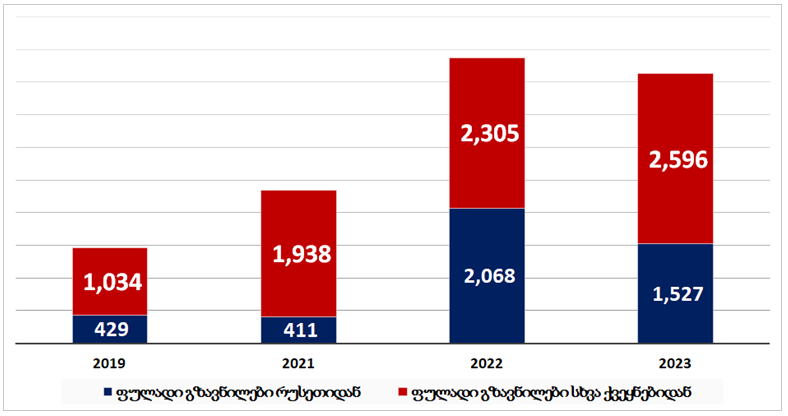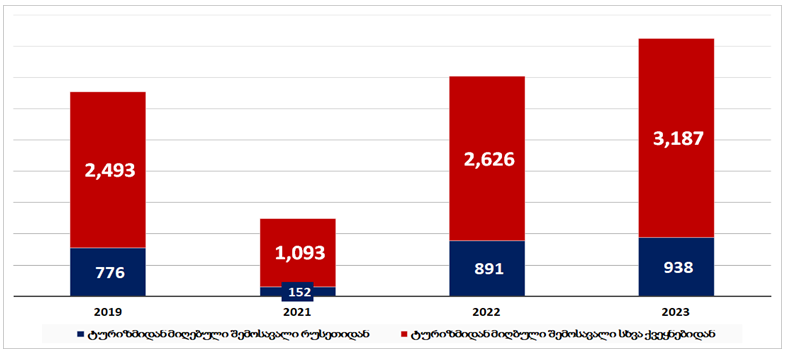Zurab-Girchi Japaridze: “The twenty-two-percent growth of the USD-denominated economy was due to the exchange rate fluctuations resulting from the Russian migration.”
Verdict: FactCheck concludes that Zurab-Girchi Japaridze’s statement is MOSTLY TRUE.
The national currency-denominated gross domestic product (GDP) is initially calculated in GEL and then converted into USD in Georgia. Inflation and fluctuations in exchange rates (when calculating the GDP in foreign currency) can lead to either an over or underestimation of the nominal economy as compared to the real economy.
The average exchange rate of GEL to USD was 2.91 in 2022, appreciating by 10.6% to 2.63 in 2023. Despite inflation decreasing to 2.5% during the same period, it still had an additional slight impact on the nominal growth of the GDP.
Fluctuations in the exchange rate are influenced by foreign currency influx as well as monetary and fiscal policies. Moreover, certain speculations and shocks further affect the short-term fluctuations.
The volume of cash flows from Russia to Georgia increased following Russia’s full-scale invasion of Ukraine with the increase in money transfers becoming particularly evident in 2022. Russia’s share in cash flows constituted 37% in 2023, although twice higher than 2021, but still lower than the peak figure in 2022.
Monetary transfers and tourism revenues from other countries increased as well. Furthermore, the monetary policy remained tight, indicating that Russian migrants did not solely influence exchange rate fluctuations.
The first part of the Girchi political party leader’s statement, claiming that the 22% nominal growth of the economy can be attributed to fluctuations in the exchange rate, is accurate. However, the latter assertion, linking the appreciation of GEL to Russian migrants is partially true. Thus, FactCheck concludes that Zurab-Girchi Japaridze’s statement is MOSTLY TRUE.
Analysis:
The leader of the Girchi – More Freedom political party, Zurab-Girchi Japaridze shared a screenshot of the TV Imedi post, stating: “So, when Russians fled the war, brought in USD, it led to fluctuations in the GEL-to-USD exchange rate. As a result, the GEL-denominated economy, when divided by the new exchange rate, translated to a higher amount denominated in USD – thus, this is the reported ‘22% growth of the USD-denominated economy’.”

Zurab-Girchi Japaridze’s statement is comprised of two assertions: 1) the 22% growth of the USD-denominated economy resulted from the changes in the exchange rate and 2) the surge in the Russian migration was the sole reason of the aforementioned changes.
The growth of the Georgian economy constituted 7.5% in 2023 according to the National Statistics Office of Georgia. The three-fold higher growth rate, when calculated in USD, was influenced by the changes in the exchange rate and inflation.
Market economies generally experience fluctuations in both inflation and the exchange rates which can sometimes lead to the nominal economy overestimating or underestimating the real growth. In some cases, the real economy may expand whilst the nominal economy declines or vice versa.
Although the GDP increased by 3.4% in 2015, the USD-denominated GDP per capita experienced a decline of 15% from USD 4,800 to USD 4,100 due to GEL depreciation. If the average exchange rate of GEL to USD constituted 1.77 in 2014, the 2015 figure was 29% higher at 2.29. On the contrary, the real economic growth of 11% in 2022 amounted to a 32% growth rate from USD 5,085 to USD 6,730 when converted to USD. The average exchange rate amounted to 3.22 in 2021 and 2.91 in 2022. The appreciation of the currency, amplified by 11.9% inflation, resulted in a 19.9% nominal growth rate of the national-currency-denominated GDP from GEL 16,375 to GEL 19,625 – a higher growth rate as compared to its real counterpart.
Whilst inflation reduced to 2.5% in 2023, GEL appreciated by an additional 10.6% from GEL 2.91 to GEL 2.63. Therefore, the per-capita nominal income in the national currency experienced a 9.9% increase from GEL 19,625 to GEL 21,370 with the USD-denominated figures expanding by 22% from USD 6,730 to USD 8,210.
The discrepancy between the nominal and real economies becomes especially evident in the longer term. Whilst the real per-capita GDP surged by 193% from 2003 to 2023, the nominal figure constituted 690%.
Despite the real figure being illustrated on the TV Imedi card, the first figure catches attention, potentially leading to an overestimated perception of the economic growth.
Whilst Zurab-Girchi Japaridze accurately suggests that the 22% nominal growth rate is attributed to the exchange rate fluctuations, the underlying reasons may vary across internal and external factors, including cash flows and tourism.
The volume of money transfers from Russia to Georgia indeed experienced an increase in 2022 and 2023. Cash flows from Russia constituted USD 411 million in 2021, later increasing to USD 2.1 billion in 2022 and remaining at USD 1.5 billion in 2023.
The tourism revenues generated from Russian citizens were USD 152 million in 2021, USD 891 million in 2022 and USD 938 million in 2023; whereas the pre-pandemic rate in 2019 was USD 776 million.
Despite the surge in cash flows from Russia in 2022 and 2023, the rise was not exclusively attributed to Russia alone as increases also occurred from other countries.
Russia’s share in money transfers totalled 18% in 2021, drastically jumping to 47% in 2022 but undergoing a correction in 2023, thus decreasing to 37% by ten percentage points.
Graph 1: Money Transfers (USD million)

Source: National Bank of Georgia
Tourism revenues totalled USD 2.3 billion in 2019, USD 1.1 billion in 2021, USD 2.6 billion in 2022 and USD 3.2 billion in 2023 when excluding Russia. Although Russia’s share in tourism revenues doubled in 2022, surpassing 25%, in reality the figure returned to its pre-pandemic counterpart as Russia’s share also totalled 25% in 2019.
Graph 2: Tourism Revenues

Source: National Bank of Georgia
External factors that are not linked to migration include external trade and direct international investments. Whilst export to Russia has witnessed marginal monetary increases, proportionally, it has decreased. Drastic changes cannot be observed in investments either.
FactCheck refrains from analysing whether foreign currency has entered Georgia from non-official channels, countries of origin, the volume of such inflows and their impact on the currency. A non-standard growth from Russia was solely observed in cash transfers in 2022 according to open-source data.
Notably, internal factors also influence the exchange rate. The National Bank of Georgia tightened the monetary policy in 2022 and 2023: the consumer loan term was reduced from four to three years, with the restriction persisting for a year. The so-called PTI coefficient declined. The restriction prevented individuals with net salaries below GEL 1,500 from loaning an amount that would require them to pay more than 25% of their salary for credit per month. For instance, if an individual’s salary totals GEL 1,200, they are prevented from making a bank contract that would require them to pay over GEL 300 per month. The refinancing rate was increased from 10.5% to 11%; however, this increase was not drastic and returned to pre-war levels in May 2023, declining even lower from August.
It can be said that whilst an increase in Russian migration has played a certain role in GEL appreciation, other external and internal factors have further influenced the exchange rate.
The first part of the Girchi political party leader’s statement, claiming that the USD-denominated nominal economy has surpassed the real growth rate, is accurate. However, the latter assertion, linking the appreciation of GEL to Russian migrants is only partially true as the exchange rate was further impacted by certain external and internal factors. Considering the accuracy of the first part of the statement, and the partial accuracy of the second part, FactCheck concluded that Zurab-Girchi Japaridze’s statement is MOSTLY TRUE.








